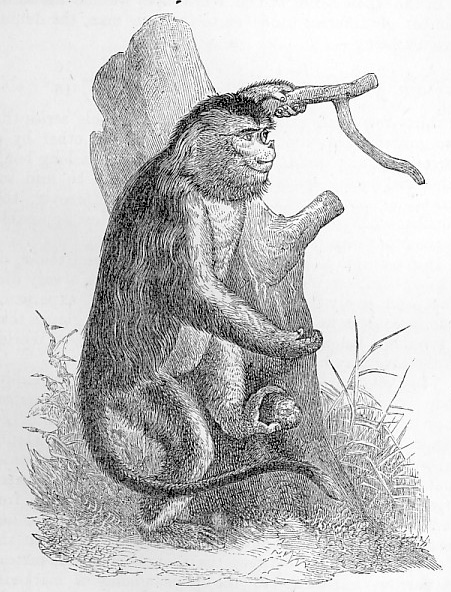1902 Encyclopedia > Ape > Ape: Family I - Simiadae, Sub-Family 2 - Semnopithecinae. Hanuman. Kahan (Proboscis Monkey).
Ape
(Part 6)
<
(B) Apes Classified by Family, Sub-Family and Genera (cont.)
Ape: Family I - Simiadae, Sub-Family 2 - Semnopithecinae. Hanuman. Kahan (Proboscis Monkey).
On leaving the gibbons, which close the series of Anthropoid apes, we come at once upon animals of very different aspect, and from creatures devoid of any vestige of a tail, we pass at once to monkeys, which have that organ at its maximum of development. These are the two genera Semnopithecus and Colobus, which so closely resemble each other as to be hardly separable, but for their different geographical distributions. Together they form the subfamily Semnopithecinae, and agree in having, as well as the long tail, arms shorter than the legs, and a slender body. They have small ischiatic callosities, but no cheek pouches. Their nails are compressed and pointed. Their stomach is very elongated and exceedingly sacculated, and their hinder-most lower grinding tooth has five tubercles. The laryngeal sac opens medianly into the front of the larynx, and is an extension of the thyro-hyoid membrane. The thumb is small or absent.
The genus Semnopithecus, in which there is a small thumb, is confined to South-Eastern Asia from the Himalaya southwards, the Indian Archipelago being its headquarters. One species, S. entellus (the hounaman [Hanuman]), is an object of religious veneration to the Hindoos. Another very remarkable kind is found in Borneo. It is S. nasalis (the kahan, or proboscis monkey), and as its name implies, it has an exceedingly long nose. In the young state, the nose is much smaller relatively, and is bent upwards.
No similar structure was known to exist in any other ape whatever till quite recently. Now, however, the Rev. Father David (a Lazarist missionary, who has made many other important discoveries in zoology) has found high up in the cold forests at Moupin in Thibet [Tibet], a large well-clothed species, with a small but distinct nose excessively turned up, on which accounts the name S. roxellanae has been bestowed upon it. It is remarkable that a form, reminding us of the young condition of S. nasalis, should have been discovered in a region so remote from the island of Borneo as is Thibet [Tibet]. It is also very remarkable that a monkey of a genus the home of which is the warm Archipelago of India, should be found in forests where frost and snow last several months in the year, when their only food is tree buds, and tender shoots and twigs.

Fig. 5 - The Proboscis Monkey of Thibet [Tibet] (Semnopithecus roxellanae). From Milne-Edwardss's Recherches des Mammifères, pl. 36.
The species of the genus to be mentioned, besides Entellus, Nasalis, and Roxellanae, are:-- Nemaeus, Leucoprymnus, Latibarbatus, Obscurus, Nestor, Cucullatus, Johnii, Priamus, Cristatus, Maurus, Femoralis, Auratus, Frontatus, Siamensis, Mitratus, Flavimanus, Rubicundus, Albipes, Nigripes, and Schistaceus.
The genus Colobus is exclusively African, but the species composing it only differ from the Semnopitheci, in that the thumb is generally absent or reduced to a small tubercle, which may or may not support a nail. The species are:-- Guereza, Verus, Temminckii, Vellerosus, Fuliginosus, Satanas, Angolensis, Ursinus, Ferrugineus, Kirkii, and Palliatus.
Read the rest of this article:
Ape - Table of Contents
|
